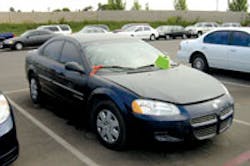Lock Decoding Made Easier With The EEZ Reader
Most wafer tumbler locks follow basic design rules that have not changed for almost 100 years. The first rule is the window in each depth of wafer is offset to match a specific depth of cut in the key. The second is the wafers rest at exactly the same position within the housing. Double-throw wafers rest in same position on opposite sides of the housing. This standardization enables the window in each wafer to be compared, resulting in the ability to determine the depths of cut required to operate the lock.
The H. E. Mitchell EEZ Readers are designed to decode the tumbler depths in single- and double-throw wafer locks. Each lock mechanism requires a specific model reader. Decoding the depths of cut using these tools require using feel, not sight reading, which is a learned technique.
An EEZ Reader has two parts: a Key Tool (modified key blank) and a slope tipped Slide Tool (manufactured of spring steel). Each Key Tool has a trap slot in the tip and a flat milled into the side of the key blank to accommodate the Slide Tool. The vertical trap slot is wider than a wafer. This allows the wafer being decoded to enter the slot and come to rest as if there were no key in the lock. Sliding the Key Tool against the wafer maintains the wafers’ position when decoded. There are two sets of scribe lines on the side of the Key Tool. The lines in the blade indicate the spacing of the wafer in relation to the cut in the key. The lines in the bow indicate the depth of cut for that wafer.
The Slide Tool has a sloped tip that serves two purposes. First, it covers the trap slot when inserting, removing, and moving the Key Tool in the lock. Second, it determines the height of the window in the wafer. An index mark on the side of the Slide Tool gauges the depth of cut against the scribe lines in the bow.
The H. E. Mitchell EEZ Readers are designed to decode wafer locks and wafer locks with sidebar. These tools are not designed to decode wafer sidebar locks. One way to distinguish a GM wafer lock from a wafer sidebar lock is by the position of the keyway opening in the shutter unit. The keyway opening in a wafer side bar lock is offset, whereas, the keyway opening in a wafer lock is in the middle.
To use an H.E. Mitchell EEZ Reader:
- Know the direction of movement for the locks’ wafers.
- Begin by decoding the wafers from the rear of the lock cylinder.
- Always use the Slide Tool when inserting, removing, or moving the Key Tool.
- Always place gentle inward pressure against the wafer being decoded to maintain its position.
- Always use gentle pressure with the Slide Tool.
For the purpose of this article, we will decode a Dodge Stratus sedan door lock. This lock contains seven staggered wafers in spaces two through eight. Because these locks are double-sided, one side must be decoded first, then the tool must be flipped over to read the other side. The EEZ Reader #EEZ Y157 is designed to decode 1995-on double-sided Chrysler wafer locks.
H.E. Mitchell recommends flushing the lock with a degreaser before decoding to insure proper operation. NOTE: Be certain the degreaser does not damage the paint.
Step 1. Test the operation of lock. The lock must be in operating condition to be decoded.
Step 2. Place the Slide Tool into the Key Tool slot covering the trap slot.
Step 3. Insert the EEZ Reader into the lock.
Step 4. Retract the Slide Tool to expose the trap slot.
Step 5. Settle the rear most wafer into the trap slot by rocking the Key Tool. The wafer may make a “click” sound as it enters the slot.
Step 6. Place gentle forward pressure on the Key Tool to trap the wafer in position. Note the relative location of the wafer by the scribe marks on the key blade.
Step 7. Move the Slide Tool forward toward the trap slot gently until it contacts the wafer. Read the depth by finding the scribe mark on the Slide Tool and the aligning scribe mark on the Key Tool bow. There are four scribe marks on the key bow for the four depths of cut.
Note: If the Slide Tool scribe mark does not align with one of the scribe marks in the Key Tool bow, use the shallower scribe mark as the depth of cut. The originated key will probably turn if the cut is shallow. However, it will leave an impression mark.
Step 8. Once the depth of cut has been determined, raise the wafer out of the trap slot using the Slide Tool.
Step 9. Position the Key Tool to trap the next wafer. Repeat steps four through nine until all of the wafer depths have been determined on this side.
Step 10. Remove and flip over the EEZ Reader to determine the wafer depths from the other side.
Step 11. Once all of the depths of cut have been determined, originate a key.
H. E. Mitchell EEZ Readers are available for Chrysler, Ford, General Motors, Honda, Mitsubishi, Saturn, and Toyota vehicles.
For more information, contact your local P. L. S. Distributor or H. E. Mitchell Co., 525 NE 19th Ave., Portland, OR 97232. Telephone: 800-626-5625 or 503-236-9444. Fax: 503-238-5715. Web Site: www.plsgroup.com.
